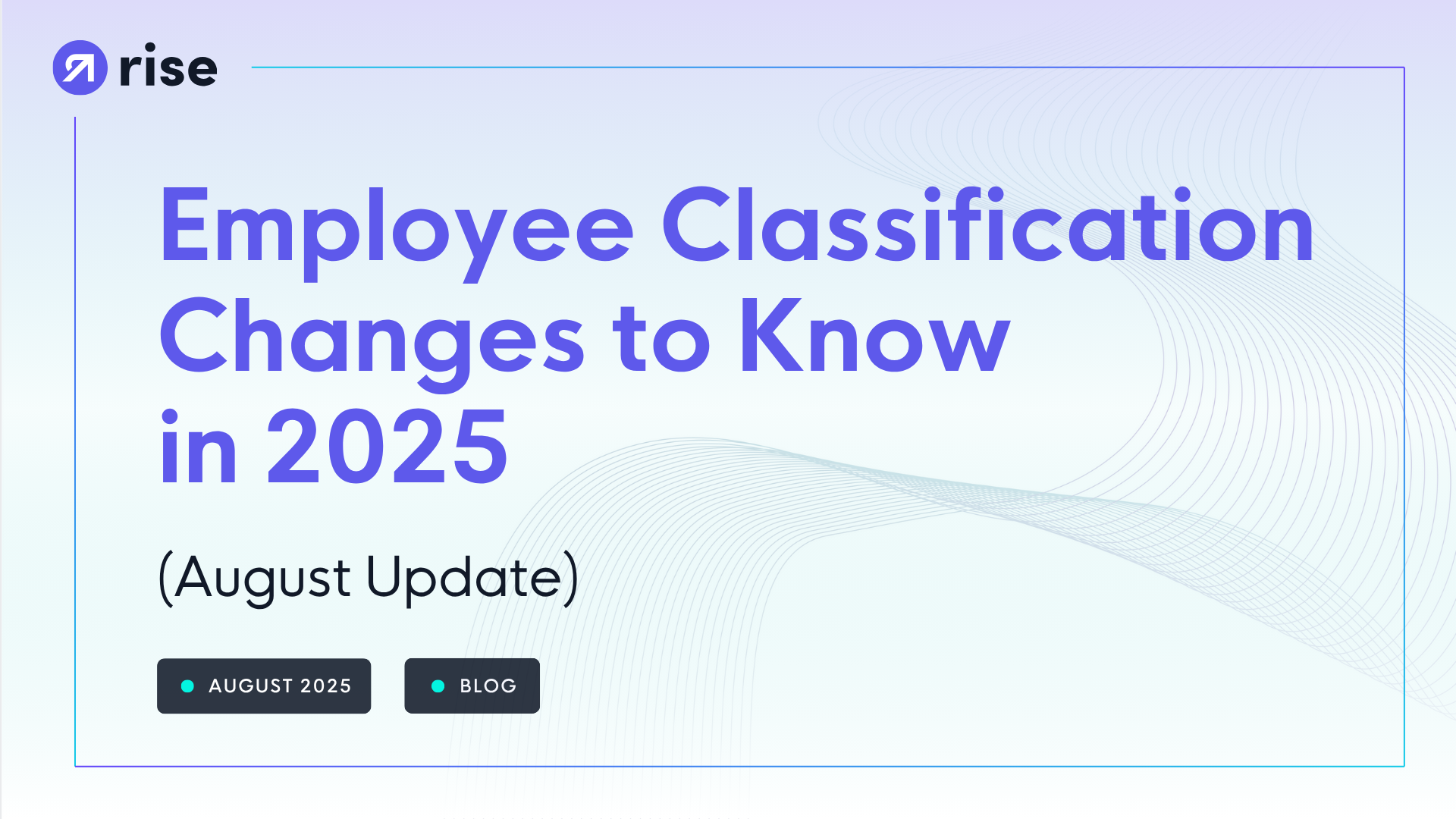Employee classification rules are changing dramatically in 2025.
Federal courts reversed overtime regulations, the DOL suspended enforcement of contractor rules, and new federal employee types are reshaping workplace hierarchy.
These changes affect every U.S. business, creating urgent compliance challenges for both exempt and non-exempt workers.
At Rise, we help businesses navigate these complexities through our comprehensive platform.
Whether you're managing contractors, hiring internationally, or ensuring FLSA compliance, we provide the tools and expertise to handle classification changes confidently.
Key Takeaways
- DOL suspended enforcement of 2024 contractor rules, creating federal uncertainty
- Overtime thresholds reverted to $35,568 annually for exempt employees
- 50,000+ federal workers face reclassification by April 2025
- State laws increasingly stricter than federal standards
- Rise's Agent of Record eliminates misclassification risk in 190+ countries
Major Federal Classification Changes in 2025
The Independent Contractor Rule Crisis
The most significant classification change in 2025 is what hasn't changed, or rather, what changed and then didn't.
The Department of Labor's 2024 Independent Contractor Rule, which took effect March 11, 2024, established a comprehensive six-factor test for determining whether workers are employees or independent contractors under the FLSA:
- Opportunity for profit or loss based on managerial skill
- Investments by the worker and the employer
- Degree of permanence in the work relationship
- Nature and degree of control over job duties
- Whether work is integral to the employer's business
- Worker's skill and initiative
However, in May 2025, the DOL announced it would no longer enforce this rule, instructing field investigators to use previously established guidance instead.
This creates a legal paradox: the 2024 rule remains technically valid law, but the agency responsible for FLSA enforcement won't apply it.
The Trump administration has signaled its intent to return to the 2021 rule, which emphasized two core factors, control and opportunity for profit or loss.
However, formal rulemaking procedures mean any official change won't happen until late 2025 at the earliest.
- In the meantime, businesses must navigate between an unenforced current rule and an anticipated future rule that doesn't yet exist, while still meeting IRS worker classification requirements for tax purposes.
This uncertainty particularly affects businesses using independent contractors for core operations.
Without clear federal standards, companies face increased risk of contractor misclassification claims from workers, state agencies, and private litigation.
- The IRS maintains its own 20-factor test for worker classification, adding another layer of complexity.
At Rise, we address this through our Agent of Record service, which eliminates classification risk by making us the legal employer of your contractors.
The Overtime Threshold Reversal
November 2024 brought another major change when a Texas federal court struck down the Biden administration's overtime rule expansion.
The court not only blocked the planned January 1, 2025 increase but also reversed the July 1, 2024 changes that had already taken effect, significantly impacting exempt and non-exempt classifications.
This means:
- The salary threshold for exempt employees returned to $35,568 annually ($684 per week)
- The highly compensated employee compensation threshold reverted to $107,432
- Automatic three-year updates were eliminated
- All employees earning below these thresholds must be classified as non-exempt under the FLSA
For context, the blocked rule would have raised the standard threshold to $58,656 by January 2025, affecting an estimated 4 million workers exempt status.
The reversal means employers who had already raised compensation levels or reclassified employees face difficult decisions about whether to maintain those changes.
- The court's reasoning focused on the DOL exceeding its authority by setting salary thresholds that effectively eliminated the duties test for exemption.
This suggests future attempts to dramatically raise thresholds may face similar legal challenges.
Our Direct Payroll service automatically applies current thresholds and manages overtime calculations, ensuring FLSA compliance regardless of regulatory changes.
New Federal Employee Classifications
The Trump administration introduced two new classification categories that fundamentally alter federal employment hierarchy and employee types:
- Schedule G Classification: Created for non-career employees in policy-making or policy-advocating positions.
These employees serve at the will of the appointing president and are expected to leave when administrations change.
Their job duties explicitly involve policy work, distinguishing them from traditional civil service roles.
- Schedule Policy/Career Classification: More dramatically, this classification targets approximately 50,000 career federal employees in policy-influencing roles.
By converting them to at-will employees, it removes traditional civil service protections including:
- Merit-based hiring requirements
- Due process for termination
- Protection from political interference
- Appeal rights for adverse compensation actions
Agencies must submit recommendations by April 20, 2025, for positions to be converted based on specific job duties criteria.
While these changes directly affect only federal workers, they signal broader shifts in employment relationships and organizational hierarchy that may influence private sector practices.

State-Level Classification Divergence
Stricter State Standards
As federal standards remain uncertain, state-level requirements have become increasingly important, and increasingly divergent from both FLSA and IRS guidelines.
Several states maintain classification tests that are significantly stricter than federal standards:
California's ABC Test: Workers are employees unless they meet ALL three criteria:
- Free from control and direction in performing job duties
- Perform work outside the usual course of business
- Engaged in an independently established trade
New Jersey: Applies similar ABC test following the Hargrove v. Sleepy's decision, affecting all employee types
Massachusetts: Uses ABC test for most employment laws, including compensation requirements
Illinois: Applies various multi-factor tests depending on the law at issue, creating complexity for different employee types
These stricter state standards mean that even if federal enforcement is relaxed, businesses still face significant compliance obligations.
A worker who might qualify as an independent contractor under IRS rules could still be deemed an employee under state law, triggering penalties and liability for unpaid overtime compensation to non-exempt workers.
New State Compliance Requirements for 2025
Beyond classification tests, states have implemented numerous new requirements affecting workforce management across all levels of the organizational hierarchy:
Pay Transparency (Effective 2025):
- Illinois, Minnesota, and Vermont join existing states requiring compensation ranges in job postings
- Requirements apply to both exempt and non-exempt positions
- Penalties range from warnings to fines up to $10,000 per violation
- Must specify base compensation separate from bonuses or commissions
Benefits Changes:
- California AB 2123: Employees no longer required to exhaust vacation before using Paid Family Leave
- Maryland: Payroll deductions for Family and Medical Leave Insurance begin July 1, 2025
- Washington: Paid Family Leave premium increases to 0.92% of wages
- New York: Paid Family Leave contributions increase to 0.388% of wages
All changes affect both exempt and non-exempt employee classifications
Other Notable Changes:
- Michigan: Paid Medical Leave Act takes effect February 2025
- Multiple states: Minimum wage increases affecting employee compensation
- Several states: New requirements for written employment agreements specifying job duties
Industry-Specific Classification Updates
Technology and Gig Economy
The technology sector faces particular scrutiny regarding contractor classification and job duties analysis.
Recent enforcement actions have targeted:
- App-based platforms classifying drivers as contractors despite controlling core job duties
- Technology companies using long-term contractors for core development work
- Startups avoiding employment taxes and FLSA obligations through contractor classification
California's continued enforcement of AB5 particularly affects tech companies, with penalties reaching millions of dollars for large-scale misclassification of employee types.
Healthcare and Professional Services
Healthcare staffing has seen increased focus on proper classification based on job duties and compensation structures:
- Traveling nurses and medical professionals often misclassified
- Telehealth providers crossing state lines face multiple IRS and state requirements
- Medical coding and billing specialists classification depends on degree of control over work
Professional services firms face challenges with organizational hierarchy:
- Consultants performing obligations similar to employees
- Long-term contractor relationships that resemble employment
- Cross-border payment services requiring IRS compliance
Construction and Manual Labor
The construction industry continues to see aggressive enforcement of classification rules, with particular focus on:
- Subcontractor relationships that function as employment
- Day laborers and seasonal workers often improperly classified
- Multi-tier contractor arrangements obscuring true employment hierarchy
- Compensation structures designed to avoid overtime obligations
Compliance Strategies for 2025
Risk Assessment Framework
Given the current uncertainty around FLSA enforcement, businesses need a systematic approach to classification that considers both IRS requirements and state law:
- Document the Actual Relationship: Focus on actual jobs performed, not contract language
- Apply the Strictest Standard: Use state law if stricter than federal FLSA or IRS rules
- Consider Economic Reality: Evaluate true independence versus economic dependence
- Regular Review: Classification isn't permanent, job duties and relationships change
Practical Implementation Steps
Immediate Actions:
- Audit all current 1099 relationships using both IRS and state-specific criteria
- Review employees near overtime thresholds ($30,000-$40,000 compensation range)
- Document classification rationale for each worker, including analysis of job duties
- Update job postings for pay transparency compliance, specifying exempt vs non-exempt status
Ongoing Compliance:
- Establish quarterly classification reviews for all employee types
- Monitor state law changes affecting FLSA compliance obligations
- Maintain contemporaneous documentation of worker independence
- Train managers and HR on classification factors throughout the organizational hierarchy
This is where Rise's platform provides crucial support.
Our AOR service eliminates classification risk for contractors, while our automated compliance tools ensure you meet all state, federal, and IRS requirements.
Technology Solutions for Classification
Modern compliance requires modern tools that can handle complex employee types and compensation structures.
Key features to look for include:
- Automated classification analysis during onboarding based on job duties
- Real-time regulatory updates for FLSA and state requirements
- Multi-jurisdictional compliance tracking including IRS obligations
- Audit trail documentation for exempt and non-exempt determinations
Our platform provides all these features, plus the flexibility to pay workers their compensation in preferred currency, whether traditional or cryptocurrency, while maintaining complete compliance across all levels of your organizational hierarchy.
Preparing for Future Changes
Building Resilient Systems
Success requires building flexibility into your workforce model that accommodates various employee types and compensation structures:
- Diversify Worker Relationships: Use the right classification for each role based on actual job duties
- Document Everything: Maintain clear records supporting each classification
- Stay Informed: Monitor regulatory changes affecting FLSA compliance actively
- Have Contingency Plans: Be ready to adjust classifications and compensation if needed
Rise's modular platform supports this flexibility across all organizational levels.
Use Global Contractor Pay for clear contractor relationships, Agent of Record where classification risk exists, and our EOR service when you need true employees without establishing entities.
Conclusion
The 2025 classification landscape demands new approaches.
With FLSA enforcement suspended, overtime thresholds reversed, and state requirements diverging from IRS standards, traditional workforce management won't suffice.
Our comprehensive platform, from Agent of Record protection to global payroll solutions, provides the tools needed to navigate these challenges.
We handle classification complexity so you can focus on growth.
Book a demo today and see how we can simplify compliance for all employee types.
FAQs:
1. What is the current status of federal independent contractor rules under the FLSA?
The 2024 Rule is technically valid but not enforced. Businesses must balance the unenforced FLSA rule with IRS requirements while awaiting new guidance expected in late 2025.
2. How do the overtime threshold changes affect exempt and non-exempt employees?
Employees earning under $35,568 annually are non-exempt and eligible for overtime. The threshold for exempt status reverted from the planned $58,656 increase.
3. Which states have the strictest classification requirements for different employee types?
California, New Jersey, and Massachusetts use ABC tests requiring all criteria be met for contractor status. These exceed both FLSA and IRS standards.
4. What are the new federal employee classifications about in terms of hierarchy?
Schedule G creates political appointments while Schedule Policy/Career converts 50,000+ career positions to at-will status, reshaping federal employment hierarchy.
5. How can Rise help with FLSA and IRS classification compliance?
Our Agent of Record service eliminates contractor risk. Global Contractor Pay automates compliance checks. All services monitor FLSA and IRS requirements continuously.















-9Aug2024.jpg)



